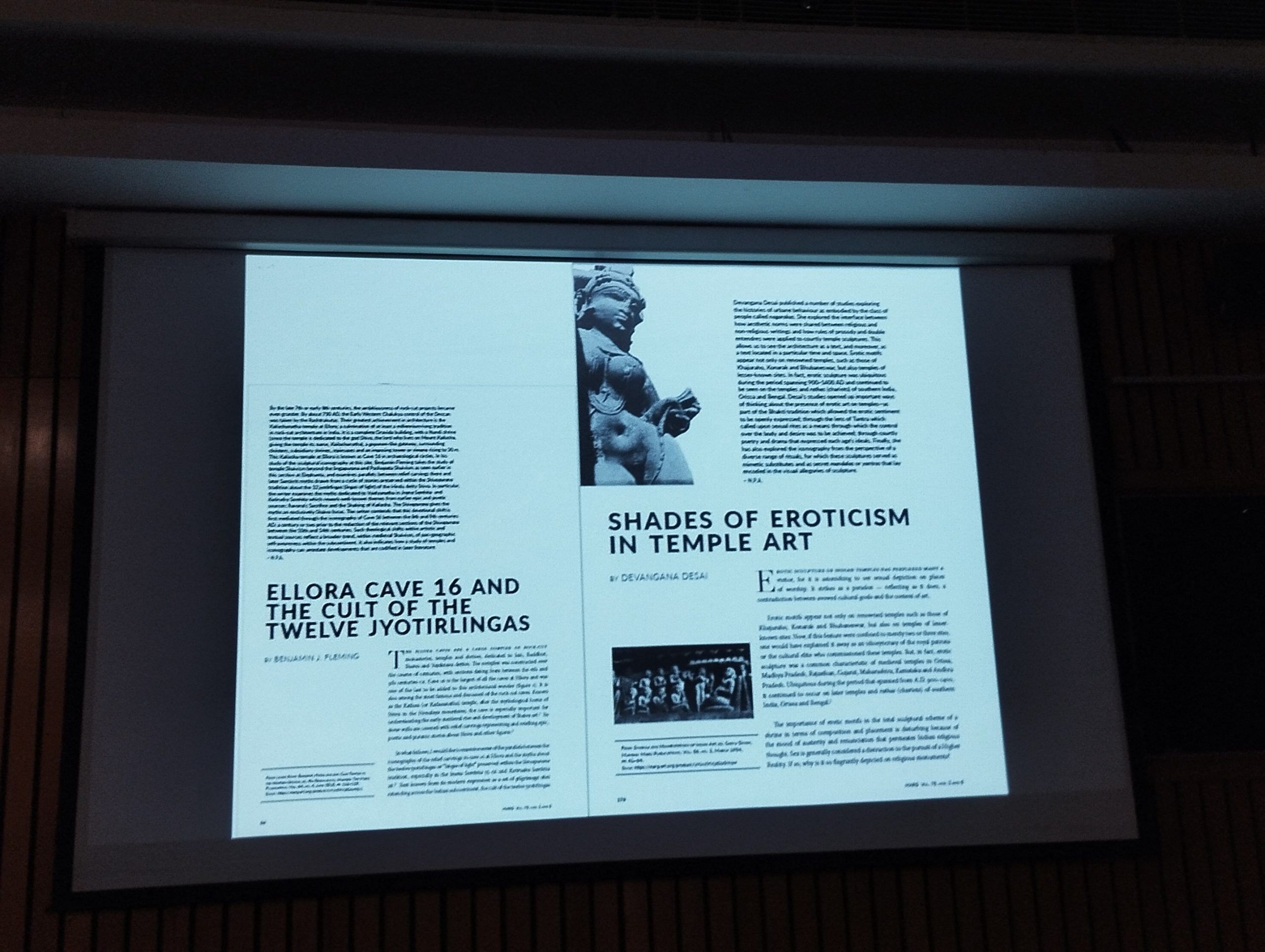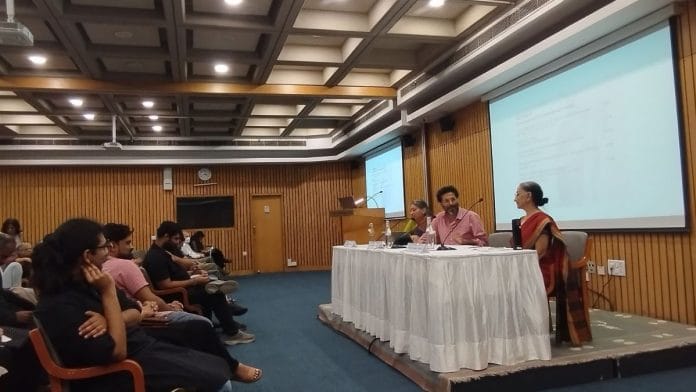New Delhi: “Who wants temples? Why do we need them? Why are they important when temples are not essential for Hindu worship?”— Professor Naman P Ahuja, Dean of the School of Arts & Aesthetics at Jawaharlal Nehru University and General Editor of Marg Publications, surprised a packed hall at the India International Centre with these pointed questions.
Speaking at an event celebrating 75 years of the Marg Foundation, Ahuja presented a curated selection of articles from its archives on the various aspects of Indian temples—as places of worship, centres of art and performance, and judicial and economic institutions.
Marg, founded in 1946 by Mulk Raj Anand, is a Mumbai-based quarterly art magazine and book publisher that highlights India’s artistic heritage and fosters discussions on museums, monuments, and art education.
“Temple worship matters to some, but if one attempts to build a civilisational history based on temple art and architecture, it becomes a history of some, not all,” said Ahuja.
He discussed Hindu temple art and architecture, noting the long-standing debate over image and non-image worship. He emphasised that concepts like Arup (formless), Nirgun (without qualities), and Nirakar (without shape or form) are central to many Hindu religious sects and are vital terms in understanding their beliefs.
In their readings at the event, guest editors Dipti Khera, Associate Professor of Art History, New York University, Abigail S McGowan, Associate Professor of History, University of Vermont, and Mayank Mansingh Kaul, designer and writer, discussed topics such as textiles and dance. They brought together histories written by both practitioners and historians that have contributed to the evolving discourse on cultural heritage and the shifting artistic and aesthetic practices in post-Independence India.

For Ahuja, the validity of temples as spaces for worship and invoking the divine is intriguing, especially in historical debates. He turned to Gudrun Bühnemann from the University of Wisconsin, who studied the migratory nature of populations, to understand the phenomenon.
According to her research in Smarta traditions and Brahman rituals in western India, a temple can be created through ritual practices. A Mandal can be established wherever five household powders are placed for a ritual. Family members gather and perform the ritual, and the space becomes a temporary temple. Once the ritual ends, the Mandal is dispersed.
“It’s a temple on the move. It’s a temple in the mind. It’s knowledge that’s kept in the head and it’s not actually manifested into a physical infrastructure,” said Ahuja.
Also read: Gargi Vachaknavi – India’s first woman philosopher who ‘shut up’ men in King Janaka’s court
Origin and politics of the temple
In discussing the origins of temple worship, Naman P Ahuja referred to S Settar’s provocative work, which revisits the Aryan-Dravidian debate. Settar argues that if temple worship originated in sedentary Dravidian culture, then examining ancient megalithic society is crucial to understanding early worship practices. Vedic texts lack information on temple worship and urban construction. Settar suggests focusing on Dravidian history rather than misleadingly attributing these practices to Aryan traditions.
“This (temple) isn’t part of Arya worship if we’re reconstructing these histories. These very powerful and important questions are often obfuscated in today’s history teaching,” Ahuja added.
Three projectors on the brown wooden wall of the hall displayed historical articles from the magazine, all showing the same content. Ahuja presented clear, new points about the politics of temples that kept the audience hooked.
Religious institutions, Ahuja explained, shaped urban landscapes and hierarchies. Temples managed vital resources like water networks, and created caste-based hierarchies in the process. The use of Prakara walls, which separated access to sacred areas, further entrenched these hierarchies and influenced social stratification in urban development.
Ahuja then proceeded to highlight broader conflicts between the state and temples, such as in Nepal’s Bhaktapur, where a priest aimed to rebuild the Nyatapola Temple taller than the palace after an earthquake. The king opposed it, creating a power struggle that reflected the tension between religious and political authorities.
Ahuja spoke about how contemporary developments of temples relate to historical patterns. The two major styles of temple architecture are Nagara in the North and Dravidian in the South. The third, Vesara, is a fusion of both. The Varanasi temple corridor has been built in a fourth style, the Shikhara, which features simple white marble and no ornate decorations.
According to Ahuja, temples in South Asia were built not only for Hindus but also for Buddhists and Jains, each featuring distinct architecture. These temples served as public gathering spaces and played a vital role in mobilising communities, especially through pilgrimage. They also had significant economic functions, and attracted both residents and foreigners. This highlights the interplay between pilgrimage economics and urban development.
Subsequently, Ahuja spoke about the importance of Rath Yatras. “Temple festivals exist. Rath yatra exists. But why do they have so much political power?” Ahuja asked.
Historically, many people faced caste-based exclusion from temples, raising questions about whose temple and history are represented. But modern-day Rath Yatras and temple festivals represent a shift. They suggest God reaching out to the people, rather than people coming to God in temples.
Also read: When did large Hindu temples come into being? Not before 500 AD
Dance and textile
The Marg has extensively documented the transformation of temples, dance, and textiles, showcasing how these sectors have evolved and formalised. These are also the “hot topics” of the current times. Guest editors such as the academics Anita Elizabeth Cherian, Urmimala Sarkar Munsi, and Abigail McGowan made presentations based on their Marg articles on dance and textiles.
Cherian, associate professor at Ambedkar University, and Munsi, professor at Jawaharlal Nehru University, called the late 1940s pivotal for cultural studies. They emphasised at the event Marg’s role as a key commentator and documenter of this period.
Through the archives of Marg articles on Indian dance, it is easy to understand how colonialism, decolonisation, and nation-building have significantly altered earlier methods of teaching and patronage.
At the event, a video featuring McGowan highlighted the evolving role of textiles in modernism.
Here, she has highlighted how, in the late 19th century, middle-class women experimented with new ways of wearing saris to express their modern identities. Focusing on textiles also reveals the importance of markets and trade, exemplified through colonial-era textile labels and post-Independence advertisements.
“We’re comfortable with textiles as commodities because trade in textiles was so central to the rise of the English East India Company and British rule,” McGowan added in her video.
(Edited by Zoya Bhatti and Theres Sudeep)






